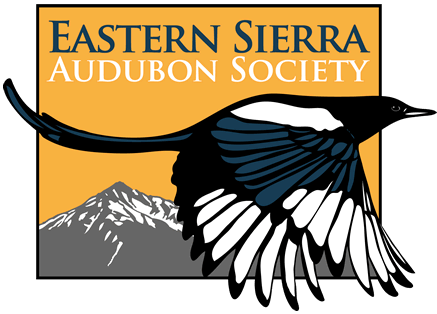The State of California and the United States Government try to protect plant and animal species that are in trouble. Species in serious decline may qualify for listing in one of several categories that, hopefully, will lead to their recovery. These are as follows:
SE= State listed as endangered
ST= State listed as threatened
SCE= State candidate as endangered
SCT= State candidate as threatened
FE= Federally listed as endangered
FT= Federally listed as threatened
FPE= Federally proposed as endangered
FPT= Federally proposed as threatened
Of the twenty-eight species of birds currently listed, eleven are found in Inyo County. The BALD EAGLE (SE, FE) is a locally uncommon winter resident of the Owens Valley. They normally arrive in early November and remain until late March. From one to three may be found at Tinemaha Reservoir and up to four have been seen at Haiwee Reservoir. There are no documented records of successful nesting. In March & April 1990 a pair made a nest at Tinemaha but deserted it the last week of April. Habitat destruction and eggshell thinning were the initial causes of the decline of our national emblem but with the protection provided by federal and state governments the eagles are making a comeback.
The SWAINSON’S HAWK (ST) is an uncommon summer visitor. These birds return in early April after an 11,000-17,000 mile trek from their wintering grounds in Argentina. They nest in large trees around ranches and feed primarily on grasshoppers and ground squirrels which are abundant in the nearby fields. They formerly occurred in flocks of hundreds but hunters have taken their toll and a recent flock of thirty-four non-breeding immatures near Big Pine was cause for celebration.
The PEREGRINE FALCON (SE, FE) is a rare transient and very rare summer and winter visitor. Most records are from August to October but there are a few spring records from April to early May. Eggshell thinning, caused by DDT, was the initial cause of their decline. When the chemical companies could no longer sell DDT in the US they shipped it to foreign countries. Those birds which migrate to DDT-using countries are eating poisoned birds and when they return to the US their eggshells are affected and their reproductive rates are low. This has been offset by captive breeding programs but as these are phased out the Peregrine’s problem will persist.
The CALIFORNIA BLACK RAIL(ST), the smallest member of the rail family, has been recorded only once in Inyo County at Little Lake early in 1964. Habitat destruction along the coast, the Colorado River & the Salton Sea has seriously reduced its numbers. It is unknown why this bird was so far afield.
The GREATER SANDHILL CRANE (ST) is a rare migrant in fall and a very rare winter visitor and spring migrant. Most records are from mid-October until mid-November with one spring record (14 April 1991 at Tinemaha) and one winter record (winter 1964-1965 at Furnace Creek Ranch). Again, habitat destruction has seriously impacted this long-limbed bird.
There are six records for the tiny CALIFORNIA LEAST TERN (SE, FE) in Inyo County. All are from late May to early June and all but two are from Tecopa and Furnace Creek Ranch. The two exceptions were seen at Owens Lake. Habitat destruction along the California coast has ruined most of their nesting areas. Their salvation is coming slowly by fencing in certain colonies to prevent accidental egg crushing by beach-goers and purposeful destruction by pets allowed to run loose.
The WESTERN YELLOW-BILLED CUCKOO (SE) is a rare transient and probable breeder in Inyo County. They return from Central and South America in late May and early June and normally depart by the first week of September. These shy and reclusive birds are most commonly observed near Tecopa, Furnace Creek Ranch, Lone Pine and Big Pine where they have been observed courting and carrying twigs. The cuckoo requires a certain amount of riparian habitat and as that is destroyed reproduction becomes impossible.
The WILLOW FLYCATCHER (SE) is a fairly common spring and fall migrant but very rare (and probably extirpated) as a breeder in our area. They arrive in mid-May and depart by early September. This small bird was once common but nest parasitism by Brown-headed Cowbirds has all but eliminated it from breeding in many areas.
The BANK SWALLOW (ST) is a fairly common migrant and a rare, local summer breeder. Migrants pass through during April and May and again in August and September. In 1891, A. K. Fisher listed it as a common breeder in the Owens Valley. In 1992 the only known breeding colony in Inyo was destroyed by workers at a local gravel pit.
The LEAST BELL’S VIREO (SE, FE) was formerly a fairly common breeder along the Owens River. Now it is a rare and local summer resident known only from Tecopa and Furnace Creek Ranch. The main threat to this tiny gray bird is nest parasitism of the Brown-headed Cowbird who chooses to let others raise its young.
The INYO CALIFORNIA TOWHEE (SE, FT) is a very local resident of the southeast Argus Mountains with a total population of around 100 individuals. The main threats are from mining activities, feral burros, off-road vehicles and riparian destruction. With a population this small the edge of extinction is a hair’s breadth away.
Tags: falcon, flycatcher, hawk, owl, vireo
